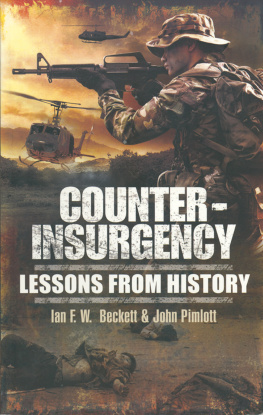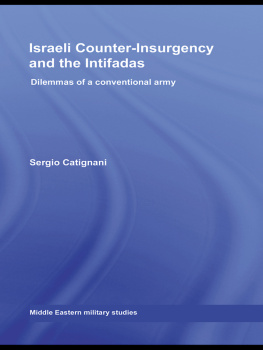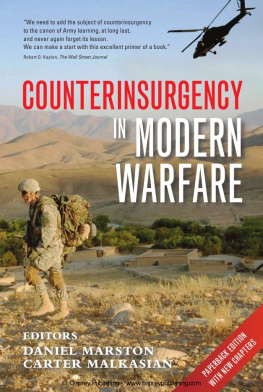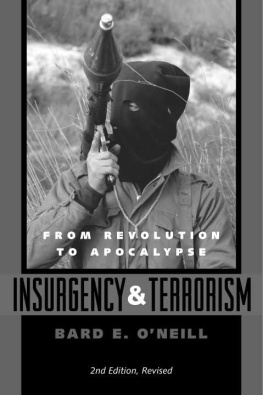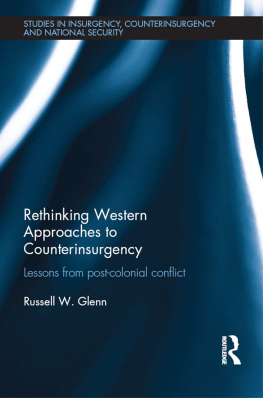First published in Great Britain by Croom Helm in 1985
Repubished in this format in 2011 by
Pen & Sword Military
an imprint of
Pen & Sword Books Ltd
47 Church Street
Barnsley
South Yorkshire
S70 2AS
Copyright Ian F. W. Beckett and John Pimlott, 1985, 2011
ISBN 978 1 84884 396 7
The right of Ian F. W. Beckett and John Pimlott to be identified as
Authors of this work has been asserted by them in accordance
with the Copyright, Designs and Patents Act 1988
A CIP catalogue record for this book is
available from the British Library
All rights reserved. No part of this book may be reproduced or
transmitted in any form or by any means, electronic or mechanical
including photocopying, recording or by any information storage and
retrieval system, without permission from the Publisher in writing.
Printed and bound in England
by CPI
Pen & Sword Books Ltd incorporates the imprints of
Pen & Sword Aviation, Pen & Sword Maritime, Pen & Sword Military,
Wharncliffe Local History, Pen & Sword Select,
Pen & Sword Military Classics and Leo Cooper,
Remember When, Seaforth Publishing and Frontline Publishing
For a complete list of Pen & Sword titles please contact
PEN & SWORD BOOKS LIMITED
47 Church Street, Barnsley, South Yorkshire, S70 2AS, England
E-mail: enquiries@pen-and-sword.co.uk
Website: www.pen-and-sword.co.uk
Back in 1985, when the first edition of this book was published as Armed Forces and Modern Counter-insurgency, there seemed little interest in counter-insurgency, at least not in Britain. There were a handful of general histories of guerrilla warfare, often of a popular rather than an academic kind. Moreover, despite the fact that guerrilla warfare had always been the most prevalent form of conflict and certainly so in the twentieth century, if not before, counter-insurgency was little studied. This was all the more surprising in the case of the British experience of warfare, the instances of conventional warfare as opposed to some form of low intensity conflict since 1945 being few. In so far as any British counter-insurgency campaign had been seriously analysed, it was the Malayan Emergency of 194860 that held the field, not least because of its central role in formulating the principles of counter-insurgency espoused by the influential Sir Robert Thompson.
In 1971, however, Frank Kitson had challenged the assumptions underpinning Thompsons approach. Kitson had called for British soldiers not only to consider the practical requirements of counter-insurgency but also to look beyond the Malayan example. New ideological, political and commercial imperatives encouraging intra-state conflict and insurgency were already beginning to emerge amid the breakdown of the international bipolar political system and the emergence of identity politics and of many more non-state actors. It is a trend that has continued ever since so that varying forms of low intensity conflict are even more familiar now than in the mid 1980s.
It was in the spirit of Kitsons challenge that the late John Pimlott and myself introduced counter-insurgency as a special subject for study at the Royal Military Academy, Sandhurst in the early 1980s. In the fifteen years that I taught war studies at Sandhurst between 1979 and 1994, the syllabus changed with bewildering rapidity and the course lasted only a few years. It gave rise, however, to Armed Forces and Modern Counter-insurgency, the intention being to arrive at a general framework for analysis that could then be applied to a variety of different campaigns. Ronald Haycock had edited a rather discursive collection of essays, Regular Armies and Insurgency, in 1979. It seemed to John and myself that, while this collection was similarly organised as a series of case studies, it did not require individual authors to try to conform to such a analytical framework as we envisaged. Subsequently, the case study approach has remained popular as in David Charters and Maurice Tugwells edited collection, Armies in Low-intensity Conflict: A Comparative Analysis (1989) and Daniel Marston and Carter Malkasians Counterinsurgency in Modern Warfare (2008). Subsequent to Armed Forces and Modern Counter-insurgency, a similar methodology of analysis was used in my edited collection, to which John contributed, The Roots of Counter-insurgency: Armies and Guerrilla Warfare, 190045 (1988)
Inevitably, as in the latter case, work undertaken since 1985 has both modified the analysis of some campaigns we explored but also extended knowledge of other counter-insurgency campaigns such as the Troubles in Northern Ireland, which continued until 1997. Equally, of course, the South African experience analysed by Francis Toase in 1985 changed substantially with the agreement on majority rule in 1994. Ironically, many former insurgent movements once in power were themselves faced by insurgency, as suggested by the essay collection, The Counter-insurgent State, edited in 1997 by Paul Rich and Richard Stubbs.
In many respects, the model framework suggested by Armed Forces and Modern Counter-insurgency remains just as valid now as in 1985. Rather than Thompsons classic five principles the model suggested was a six-fold one. Following recognition of the political nature of insurgency, the second basic requirement of a successful counter-insurgency strategy appeared the recognition of the need to ensure co-ordination of the military and civil response; a third, the need to ensure co-ordination of intelligence. A fourth requirement was the separation of the insurgents from their base of popular support either by physical means or by a government campaign designed to win the allegiance of the population. A fifth requirement was the appropriate use of military force against those insurgents separated from the population. Finally, long-term reform addressing those political and socio-economic grievances that have contributed to the insurgency was necessary in order to ensure that it did not recur. Examining each of the case studies in these terms was the key to an understanding of why some had succeeded and others failed.
Much of this is now widely accepted. Whatever the degree of support for it, insurgency can only be realistically tackled through a primarily political response. Where initial support for insurgency amongst an uncommitted population depends upon the exploitation of particular grievances then attention to those grievances on the part of government may perhaps be more significant than the perception of winning and losing. Clearly, government needs to project a viable political and socioeconomic programme that offers significantly more future promise than that of the insurgents. Yet, the ability of government to address fundamental grievances may be part and parcel of that wider perception of winning and losing. The populations overall sense of security is the key whatever other tangible rewards may be on offer from one side or the other and, indeed, without security it may not be possible to deliver other rewards.
To win a counter-insurgency campaign, therefore, implies establishing sufficient legitimacy to incorporate a critical mass of the population within the government camp. Establishing or re-establishing legitimacy will also imply promoting a sense of credible security as a basis for governance. In essence, this is a matter of winning hearts and minds. It has been suggested on occasions that if you have them by the balls, their hearts and minds will follow, but, while this may convey an element of truth, the reality is that victory will go to those who are best able to meet both security concerns and basic aspirations. Most models of counter-insurgency, therefore, recognise the imperative of putting into place sufficient reforms and mechanisms to ensure that the insurgent challenge will be neutralised and will not recur.
Next page
